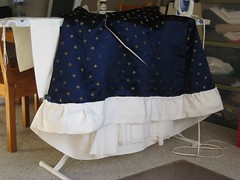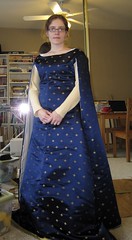Sometimes you've just got to put your butt in the chair and work on things, even if you're not inspired.
I realized I had a whole day for projects, with nothing planned, and I figured I'd just start working on this dress again so that I can get it off my 'in-progress' list. I still hadn't decided on a floor-skimming vs. a puddling-on-the-floor length, but after trimming the main fabric so it was even, it became obvious that I didn't have enough length to puddle convincingly anyway. So I trimmed off another 4 cm or so, and zig-zagged a 1 cm hem to keep the fabric in check while I worked on the rest.
The turned-up contrast of the lining fabric I've decided to do as an applied band rather than actually turning up the lining (which you can see hanging down in the center of the photo). There are four thicknesses total - 2 lengths of fabric, folded over and pressed at the top of the band. The bottom two layers are sewn to the very edge of the dress to secure them, and the upper layers have extra length which will be folded under and tacked on the inside.
Of course, since the band is straight and the skirt is flared, it is inevitably a bit too wide at the top. My current debate is whether to ease the extra through the entire width (on the right on the photo), or to keep it as smooth as possible and take a few darts in the section over the gores as necessary (on the left). I'm strongly leaning toward the latter, but I'm going to stare at it for a day or two before I commit to one or the other.
26 October 2008
24 August 2008
Continuing progress on Très Riches Heures gown
Neither I nor this dress are dead yet. I've just set in the sleeves and started attaching the lining.
24 June 2008
Gown assembly
A bit of progress on the Très Riches Heures gown: I've done the preliminary fitting, so it's not quite so oversized. I cut back the lining to match the adjustments to the fashion fabric, and started assembling that. I went back and cut the gores for the lining as well, since I had neglected to do that originally. It may still need to be taken in further, but its starting to shape up. Once I finish assembling the lining, I should be able to set in the neckline and armholes.
As it currently stands, the gown is cut a bit beyond floor length, the idea being that it would puddle on the ground, but the fabric just has too much body to 'puddle' properly. I'm debating trimming the hem down to just barely floor length in the hopes that it might drape better (and be more likely to be worn, honestly), but it might actually make things worse instead. Looks like I'll be perching on stacks of books in the near future to get an idea of how it would behave.
This is probably a bad sign, but I've starting thinking about contingency plans for what I could re-cut the fabric into if this gown doesn't work. A late 16th century forepart skirt is near the top of that list.
As it currently stands, the gown is cut a bit beyond floor length, the idea being that it would puddle on the ground, but the fabric just has too much body to 'puddle' properly. I'm debating trimming the hem down to just barely floor length in the hopes that it might drape better (and be more likely to be worn, honestly), but it might actually make things worse instead. Looks like I'll be perching on stacks of books in the near future to get an idea of how it would behave.
This is probably a bad sign, but I've starting thinking about contingency plans for what I could re-cut the fabric into if this gown doesn't work. A late 16th century forepart skirt is near the top of that list.
10 May 2008
Pushing forward: sleeves done
I've now finished both sleeves, shown in extreme close-up here. Next up is going to be fitting the main gown - I left a lot of ease when I did the cutting, so it's approximately the right shape but rather oversized. Combined with the strong hand of the fabric, it looks like its wearing me rather than vice versa. Pulling it in to be more body skimming should (hopefully) bring that under control.
09 May 2008
WIP, or just a UFO?
I'm very slowly making progress on my Très Riches Heures gown (no pictures right now), but it's beginning to feel like less of a work in progress and more like a (perpetually) unfinished object. The distinction being the optimism, or lack thereof, about whether it will ever be finished. The lining is very thin, which by itself isn't a problem, but when I turned and pressed the first sleeve, the seam allowances and the fray-prevention zigzag on them showed through in a very unattractive way. I unpicked the zigzag all the way around, painstakingly trying not to create any snags or pulls in the satin. Then I re-bound the edges, using an extra fold and much lighter thread, and re-pressed it all once again. It looks much better now, and I know how to handle the second sleeve now, but it was frustrating to spend an entire long evening on the project just to get back to where I started in terms of assembly progress.
I'm also worried that the fabric ultimately won't drape right at all. Heavy satins drape very differently on the grain and the cross-grain (e.g., do the floats run vertical or horizontal on the garment), and I'm afraid I'm going to end up with something that stands out stiffly rather than falling in nice folds. From the moment I saw it, this fabric insisted it wanted to be this gown, but I'm beginning to think that it lied.
I'm also worried that the fabric ultimately won't drape right at all. Heavy satins drape very differently on the grain and the cross-grain (e.g., do the floats run vertical or horizontal on the garment), and I'm afraid I'm going to end up with something that stands out stiffly rather than falling in nice folds. From the moment I saw it, this fabric insisted it wanted to be this gown, but I'm beginning to think that it lied.
Labels:
15th c.,
Très Riches Heures gown
03 March 2008
Finished apron dress
This dress has been done for months, but I hadn't gotten any pictures of it until now. Like I outlined in my post on creating the pattern, it's a very simple cut with 4 identical panels, and each panel has a vertical dart for tailoring. The darts in the back are much shallower than the ones in the front, and might be skipped entirely for some women. The straps are long loops made from 1 inch strips of the same fabric as the dress, folded in itself twice.
I'm happy with the overall fit and look of the dress, but not entirely satisfied with it as a recreation based on the Hedeby fragment. While I was able to incorporate most of the features of the piece, the location of the hole near the upper edge of the piece didn't match up with anywhere I could plausibly position a strap, either on the front or the back.
I'm happy with the overall fit and look of the dress, but not entirely satisfied with it as a recreation based on the Hedeby fragment. While I was able to incorporate most of the features of the piece, the location of the hole near the upper edge of the piece didn't match up with anywhere I could plausibly position a strap, either on the front or the back.
Subscribe to:
Posts (Atom)



